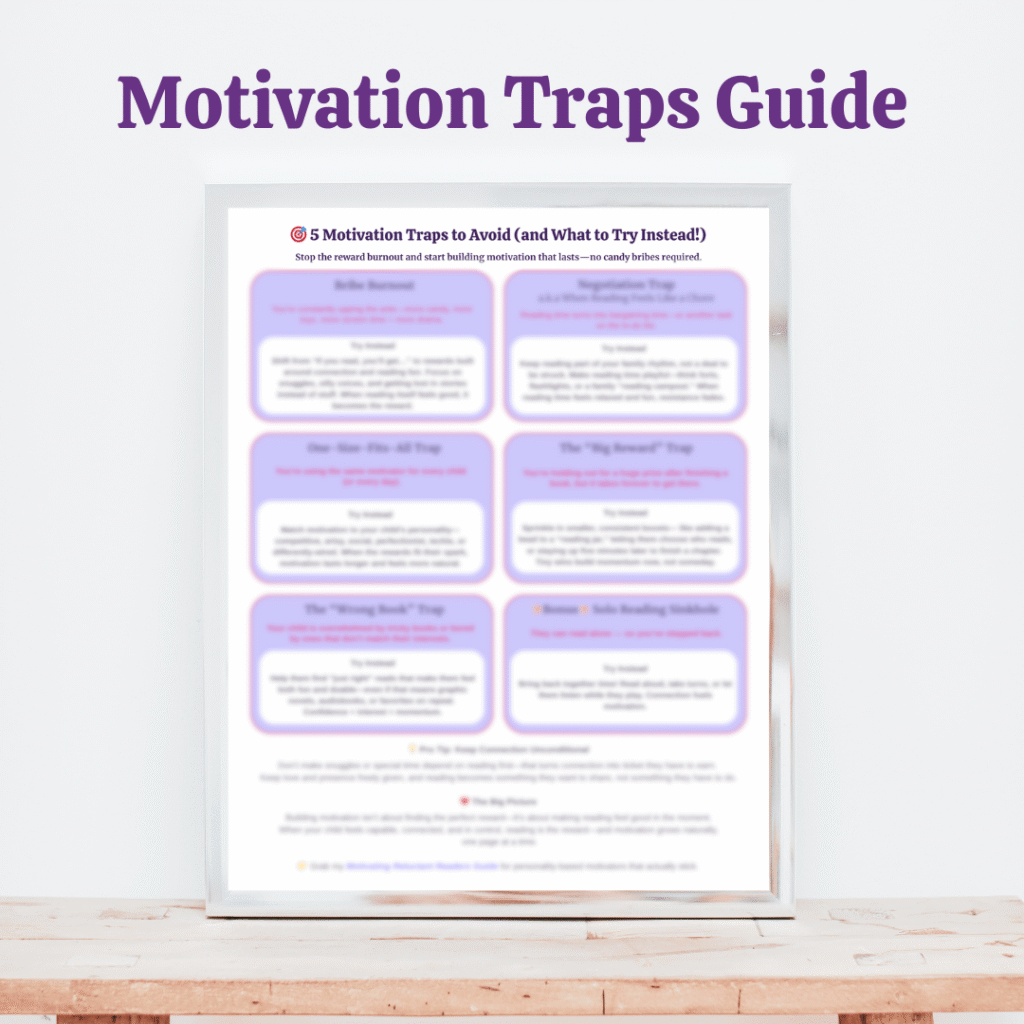Reading Rewards That Work: How to Motivate Kids Without Bribes
🎧 Prefer to listen?
This post is also available as a podcast episode.
If you’ve ever promised, “If you do this, then you can have that…”, I get it.
Most of us have reached for a bribe at some point—candy, stickers, screen time, cold hard cash—just trying to make it through the moment without a meltdown.
I’ve been there too. And while bribes can sometimes calm the chaos, they never really built the habits I was hoping for. So when we started hitting resistance with reading, I knew that road wasn’t the answer. I needed to try something different from the start.
That’s when I began noticing a pattern: bribes can spark short-term wins, but they don’t build lasting habits.
Why Bribes Don’t Build Real Reading Habits
When we rely on bribes, we’re teaching our kids what to do, not why to do it.
The reading might happen, but the motivation belongs to the reward—not the story.
For many families, it sounds something like:
“If you read for twenty minutes, you can play your game for twenty minutes after.”
It works for a while. But soon, you’re fighting two battles: one over reading, and another when screen time has to end.
That’s the problem with bribes—they create an external push, but they don’t build the kind of internal motivation that lasts after the reward is gone.
Bribes have their moments. They help us survive tough days, and that. We all reach for what works in the moment. But they can’t do the deeper work of helping kids feel in control, capable and connected—the three things I believe drive reading motivation.
I share more about how to build on those three pillars in my free guide, 5 Motivation Traps to Avoid (and What to Try Instead)—but let’s start here.
If bribes can’t build lasting motivation, what can? That’s where understanding the real roadblock comes in.
Start Here: What’s Really Behind Reading Resistance
When a child resists reading, it’s easy to assume it’s about attitude or ability. But often, the real issue is much simpler—and more emotional.
When JD hit his first real reading slump, I had to dig deeper. For years, he’d been that kid who loved books—voracious, always lost in a story. Then, seemingly overnight, he shut down. Complete refusal. That was my signal something deeper was going on.
Because when a child suddenly says, “I hate reading,” it’s rarely about the books themselves. It’s about how reading feels. Maybe it feels too hard, too lonely, or no longer rewarding.
In JD’s case, it was all three. He’d burned through the easier books he could handle on his own and wasn’t quite ready to stretch into harder ones. And because he could read independently, I’d leaned too heavily on that. I left him there too long—reading alone, without the shared time we used to have.
He didn’t just lose interest in books. He lost us in the process.
If your child’s starting to pull away from reading together, this post on why reading aloud still matters can help you bring that connection back—and this one on family reading nights shows how to make it something everyone looks forward to.
That experience helped me see that motivation isn’t about pushing harder—it’s about building the foundation kids actually need to want to read.
The Three Pillars of Reading Motivation That Lasts
True motivation doesn’t come from rewards or reminders—it grows when kids feel in control, capable, and connected to what they’re doing.
1- In Control: When Choice Fuels Motivation
One of the strongest motivators for kids is having a say in what—and how—they read.
Because if they’re not interested in what they’re reading, they’ll never fall in love with it.
And ownership means all kinds of books count. Audiobooks count. Comics and graphic novels count. Dog Man, for however many times they’ve read it, still counts. The point isn’t the format—it’s the fact that they’re choosing. And that choice is what makes them want to come back.
For JD, that ownership has shown up in different ways over time. This year, we’ve been deep in the Percy Jackson universe—nearly a year of mythological quests and monsters—and it’s been incredible watching him step up to read a chapter here and there. These aren’t easy books; they’re full middle-grade novels. But for a fourth grader, that’s a huge confidence boost.
A couple of years ago, though, it was a very different story. I brought home the first Investigators book right as he was starting to pull away from reading. It’s a graphic novel series with quick pacing, and I’ve never loved using graphic novels as read-alouds, so it became something he’d have to read on his own. Rather than do that, he passed.
But just this past month, I grabbed one again and casually left it on the table. This time, something clicked. He started coming home after school, finishing homework, and diving into those books without me saying a word. He even took it upon himself to check out two more from the school library.
That’s ownership in action—him coming back to a story on his own terms, when he was ready.
When kids feel that sense of control over what and how they read, motivation starts to grow naturally. And that’s one of the reasons book series work like magic for reluctant readers, they give kids a world they already know and love, which keeps the momentum going.
Choosing stories they love opens the door to believing they can tackle new ones—and that’s where the next pillar comes in: feeling capable.
2- Capable: Make Success Feel Easy, Then Stretch Together
Confidence matters more than perfection.
When a book feels too hard, it can feel like failure. But when it’s just right, it feels like success—and success builds momentum.
Sometimes that means embracing the books that feel “too easy.” Those are the confidence builders—the bridge between stuck and ready. When kids experience small wins, they start to believe, I can do this.
And when it’s time to stretch into something harder, that’s where you come in. Read together. Take turns. Model how to tackle tricky words. You’re not just sharing the story—you’re showing what capable looks like.
I’ll never forget the first time JD offered to read a whole chapter after his slump. It wasn’t a long one, but that moment was huge. He went from total refusal to, “Can I read this part?” and it was all I could do not to tear up.
This summer, Hunter did the same. We started with one word at a time, then a page, and before I knew it, he was finishing an entire book on his own.
Those moments may look small, but they’re the kind that rebuild confidence one page at a time.
And when confidence wavers, that’s where connection steps in—reminding kids that reading doesn’t have to be a solo act.
If your child wants you close while they read—or asks you to read to them again—you’re not holding them back. You’re helping fill the gap until they feel ready to stand on their own.
That’s the heart of the next pillar: staying connected.
3- Connected: Presence Beats Prizes
For my boys—and honestly, for me too—the biggest motivator hasn’t been toys, sticker charts, or extra screen time. It’s been time together.
When JD hit his reading slump, I thought about bribes. I really did. But what finally moved the needle wasn’t a prize. It was presence.
I made one simple rule: he had to at least be in the room while I read. He didn’t have to sit next to me or even look at the book. He could play with his toys on the floor if he wanted—but he had to be there, listening.
Night by night, he crept closer. First on the floor, then beside me, until one night, he was reading with me again. That’s the quiet power of connection—no candy required.
And somewhere in there, I noticed something shift in me, too. I’m a recovering binge-watcher—there are nights when zoning out with a show sounds way easier than reading. But sharing Percy Jackson with JD pulled me in just as much as it did him. When we show our kids that stories pull us in too, they start to see that reading is valuable—and contagious.
If your child’s love language is quality time or physical touch, connection is like super fuel. You’re meeting their emotional needs while weaving reading right into that bond.
And it doesn’t have to take hours. Research shows that even three connection points a day—just 10 minutes at a time—can fill their cup. A quick read after school, a bedtime snuggle, or a longer weekend story all remind them that reading isn’t just something we do. It’s something we share.
Once you understand what fuels motivation, it’s easier to see how rewards can fit in without taking over.
Replacing Bribes with Motivation That Sticks
Motivation isn’t all-or-nothing—it ebbs and flows. Some books click instantly, and others flop. Sometimes we level up too soon, and that’s okay. We put books down all the time as adults, and our kids are allowed to do the same. What matters is helping them stay in the driver’s seat.
Every spark counts. Five minutes of reading is still momentum. Reading to a pet or sibling still builds confidence. And sometimes, your praise means more than any prize ever could.
The most lasting motivators make reading feel rewarding in the moment—so kids want to come back to it again and again.
That might look like:
- A bedtime snuggle to finish a chapter.
- Flashlight reading under the covers.
- A trip to the library or bookstore where they choose the next adventure.
- A new bookmark or book-themed sticker that keeps the excitement alive.
These aren’t bribes—they’re ways of celebrating effort and keeping reading connected to something that feels good.
And if you do want to sprinkle in other motivators, choose ones that deepen the habit instead of competing with it. Finishing a book that leads to a family movie night can turn a reward into connection and spark great conversations about characters and endings.
Other times, the fun itself is the reward—a living room fort, silly voices, acting out a story. Those playful moments make reading an experience your kids want to come back to. If you’re looking for more simple ways to make reading fun, I’ve shared a few of our favorites here.
And remember: rewards should never be the only way your child gets connection or fun. If reading becomes the price of admission to your time or attention, it loses its magic. The goal isn’t to remove rewards completely—it’s to choose ones that strengthen what’s already there.
The Heart of Real Reading Motivation
At the end of the day, motivation doesn’t come from what we give our kids—it grows from how we equip them.
Bribes fade. But when kids feel in control, capable, and connected, reading starts to feel like their idea—and that’s where everything changes. Because real motivation isn’t about earning a prize.
It’s about helping our kids discover that reading itself can be the reward.
Grab the Free Guide
5 Motivation Traps to Avoid (and What to Try Instead!)
If you’re ready to move past bribes and build motivation that actually lasts, this quick one-pager will show you how—no candy negotiations required.Inside, you’ll find:
☑️ What’s really behind “bribe burnout”
☑️ How to replace pressure with connection
☑️ Simple, low-stress ideas to make reading feel fun again

Suggested Resources
If you’re ready to keep building motivation (and connection) around reading, these posts go deeper into the topics we talked about here:
- Motivating Reluctant Readers Guide – Discover personality-based motivators that actually stick.
- Help Your Child Find the Books That Change Everything (Even If They Hate Reading Now) – Learn how to choose “just-right” books that rebuild confidence and spark interest.
- Why Reading Aloud Still Matters—Even After Your Child Learns to Read – Bring back shared reading time to keep connection alive.
- Family Reading Nights: Simple Ways to Connect with Your Kids – Make reading a family ritual everyone looks forward to.
- Why Book Series Work Like Magic for Reluctant Readers – Tap into the power of continuity and character connection.
- How to Balance Screen Time and Reading: Tips for Parents of Reluctant Readers – Use screens to support reading, not compete with it.
- Raising Readers Without the Pressure: How to Build a Home Where Books Belong – Create a book-friendly environment that invites reading naturally.
- 12 Easy Ways to Make Reading Fun for Kids Who Say “I Hate Reading” – Quick, playful ideas to turn reading resistance into engagement.
FAQs: How to Motivate Kids to Read (Without the Bribes)
What if my child only wants to be read to and never reads alone?
That’s completely normal. Many kids need more time before reading independently feels comfortable. Keep reading aloud and take turns with pages or sentences—it builds confidence and keeps reading feeling relaxed and enjoyable. You can read more about how shared reading supports motivation in this post.
How can I tell if my child’s books are too easy or too hard?
If your child breezes through every page without pausing, that’s a good sign they’re ready to level up—just a little. If they’re stumbling every few words or seem frustrated, the book’s probably too challenging for independent reading. Aim for a mix—some that build confidence and a few that stretch skills. I walk through how to find those “just-right” reads in Help Your Child Find the Books That Change Everything (Even If They Hate Reading Now).
What if my child used to love reading but doesn’t anymore?
Reading slumps happen! Interests shift, schedules change, and sometimes kids just need a reset. Try changing up formats—graphic novels, audiobooks, or a fun book-to-movie tie-in. Reconnecting stories to fun experiences often rekindles the excitement.
How do I handle siblings with totally different reading personalities?
Lean into their unique preferences instead of trying to use one approach for everyone. One child might love quiet solo reading while another thrives on read-aloud time or friendly competition. You can also set up small, personalized reading spots so each child feels ownership. If you’re not sure what motivates them best, the Motivating Reluctant Readers Guide breaks it down by personality.
How can I encourage reading when life feels too busy?
You don’t need long stretches of time—just consistent, meaningful moments. Ten minutes before bed, an audiobook in the car, or reading during breakfast all count. Keep books visible in everyday spaces so they’re an easy yes. I share more ideas for weaving books into real life in Raising Readers Without the Pressure: How to Build a Home Where Books Belong.
How do I motivate my child to read without using rewards or bribes?
Start by focusing on what makes reading feel good in the moment—not what they’ll get afterward. When kids feel capable, connected, and in control, reading itself becomes rewarding. Swap external prizes for small wins that build confidence and connection—like reading together, letting them choose the story, or celebrating effort over outcome. If you’re not sure where to start, grab my free guide 5 Motivation Traps to Avoid (and What to Try Instead) it walks you through the most common pitfalls parents face and how to shift toward motivation that actually lasts.


